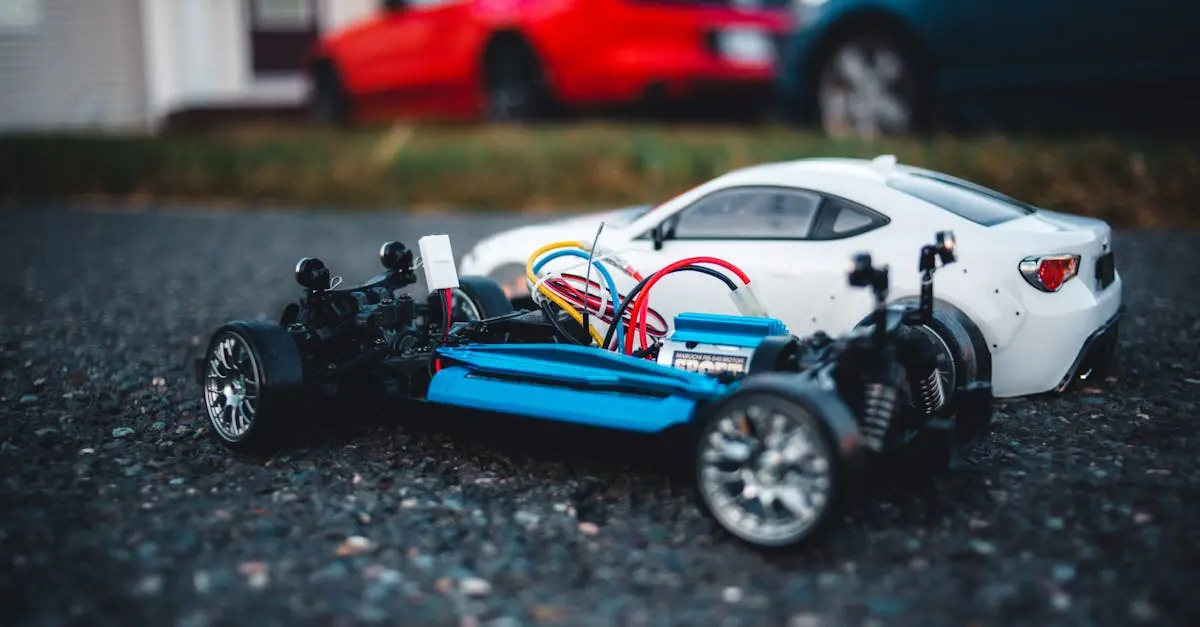Imagine transforming a pile of wires and circuit boards into something truly remarkable. DIY electronics projects offer a thrilling way to unleash creativity while mastering the art of technology. Whether it’s building a quirky gadget or a practical device, anyone can dive into this electrifying world.
Table of Contents
ToggleOverview of DIY Electronics Projects
DIY electronics projects encompass a wide range of activities that enable creative expression and technical skill enhancement. Individuals can explore various aspects of electronics, ranging from simple circuits to more complex devices. These projects often utilize accessible materials such as wires, resistor components, and circuit boards, making them suitable for beginners and seasoned hobbyists alike.
Many enthusiasts enjoy building gadgets that serve practical purposes. Examples include timers, alarms, and home automation systems. Creating a unique device like a temperature sensor can help in understanding basic electronics principles. Additionally, individuals can customize designs to fit personal needs or preferences, which adds an element of fun.
Learning by doing stands as a core advantage of engaging in DIY projects. Each project presents challenges that sharpen problem-solving skills and promote critical thinking. Resources such as online tutorials and community forums provide invaluable support, guiding people through the process step by step.
Expanding the scope of DIY electronics projects involves integrating programming elements. Many projects now incorporate microcontrollers such as Arduino and Raspberry Pi, enhancing functionality and interactivity. As a result, individuals can build advanced systems including robotics and IoT applications.
Various platforms exist for sharing these projects, allowing creators to connect with like-minded individuals. Engaging with the DIY electronics community often leads to collaboration and new ideas, fostering continuous learning. Whether for leisure or educational purposes, DIY electronics projects provide valuable opportunities for growth and innovation.
Benefits of DIY Electronics Projects
DIY electronics projects offer various advantages that enhance both skills and financial savings. Engaging in these projects not only sparks creativity but also provides numerous opportunities for learning.
Skill Development
Building DIY electronics fosters technical skills and practical knowledge. Individuals learn circuit design, soldering techniques, and programming concepts through hands-on experiences. Tackling challenges within projects strengthens problem-solving abilities while promoting critical thinking. Beginners often become proficient in tools and software relevant to electronics. Experienced hobbyists refine their skills by exploring advanced concepts and techniques. Community resources, such as online tutorials and forums, provide additional support, enriching the learning journey.
Cost-Effectiveness
Creating DIY electronics projects can be a financially wise decision. Purchasing custom gadgets often comes with a premium price tag, whereas building devices from scratch significantly reduces costs. Common components like resistors, capacitors, and microcontrollers are readily available at affordable prices. Many individuals can repurpose old electronics, minimizing expenses further. This approach not only saves money but also encourages a sustainable mindset. Through DIY endeavors, individuals discover unique solutions tailored to their specific needs without overspending.
Popular DIY Electronics Projects
DIY electronics projects offer a wide range of opportunities for all skill levels. From creating simple gadgets to advanced systems, individuals can find exciting activities to suit their interests.
Beginner Projects
Beginner projects provide an accessible entry point into the world of electronics. Basic circuits, LED blinkers, and simple buzzers are excellent starting points. These projects teach essential skills like circuit design and soldering techniques. Building a basic alarm system or a DIY timer also introduces foundational concepts in a hands-on way. Learning resources, such as online tutorials, support beginners in mastering these skills and gaining confidence.
Intermediate Projects
Intermediate projects allow enthusiasts to build on their foundational knowledge. Creating a small robot or weather station challenges one’s skills while encouraging creativity. Incorporating microcontrollers, like Arduino, opens up new possibilities for functionality. Home automation systems, such as smart lights or temperature monitors, offer practical applications that enhance everyday life. These projects foster a deeper understanding of programming and electronics, providing valuable experience.
Advanced Projects
Advanced projects cater to those seeking a significant challenge. Designing an IoT device or robotics system pushes the limits of technical skills. Combining multiple components and programming languages enhances complexity and functionality. Projects like a home security system or automated greenhouse require problem-solving and innovative thinking. Engaging in these tasks not only tests existing knowledge but also promotes collaboration with the DIY electronics community.
Essential Tools and Materials
Creating DIY electronics projects requires essential tools and materials. Mastering these supplies can enhance the building experience and promote efficient work.
Basic Tools
Soldering irons serve as crucial instruments for connecting components securely. Multimeters measure voltage, current, and resistance, ensuring accurate readings during projects. Wire strippers and cutters simplify the preparation of wires. Additionally, pliers offer support for bending and holding components in place. Flat-head screwdrivers and Phillips screwdrivers assist in securing project parts. Handy fresh batteries power devices, providing energy for testing creativity. Workbenches or sturdy tables provide ample space for assembling projects without distractions.
Components and Accessories
Resistors control the flow of current within circuits, essential for protecting sensitive components. LEDs, small yet powerful, provide visual feedback in numerous applications. Capacitors store and release electrical energy, playing a vital role in circuit operation. Microcontrollers, like Arduino and Raspberry Pi, enable programmable functionalities, powering more complex projects. Jumper wires connect components easily without permanent soldering. Breadboards allow for quick prototypes, facilitating easy adjustments during the building process. Power supplies provide necessary energy, ensuring components function properly throughout experiments.
Tips for Successful DIY Electronics
Selecting the right tools makes a significant difference in project outcomes. Essential tools include soldering irons, multimeters, wire strippers, and pliers. Each tool aids in precision and efficiency, ensuring smoother building experiences.
Gathering quality components is equally important. Reliable components such as resistors, LEDs, capacitors, and microcontrollers enhance circuit functionality. Choosing quality materials leads to longer-lasting projects and more satisfying results.
Planning projects before starting reduces errors. Sketching circuit diagrams provides clarity, outlining connections and component placement. This step minimizes confusion during assembly, promoting a thorough understanding of circuit design.
Experimenting with basic projects builds confidence. Beginners find success with simpler tasks like LED blinkers or basic circuits. As skills progress, enthusiasts can gradually tackle intermediate and advanced projects, such as home automation or IoT devices.
Utilizing online resources accelerates learning. Platforms like tutorial websites and community forums offer insights and troubleshooting tips. Engaging with the DIY electronics community fosters collaboration and continuous improvement.
Documenting each project creates a valuable resource. Recording steps, challenges, and solutions allows for reflection and future reference. This practice not only reinforces learning but also helps others in the community benefit from shared experiences.
Maintaining a safe workspace cannot be overlooked. Ensuring well-organized tools and components prevents accidents. Wearing safety goggles while soldering protects eyes, emphasizing responsible crafting practices.
Embracing challenges promotes growth and creativity. Each project presents unique obstacles that sharpen problem-solving skills. Individuals who approach issues with a positive mindset often discover innovative solutions.
Engaging in DIY electronics projects opens up a world of creativity and innovation. Whether someone is a beginner or an experienced hobbyist there’s always something new to learn and create. The hands-on experience gained through these projects not only enhances technical skills but also fosters problem-solving and critical thinking.
By utilizing accessible resources and community support enthusiasts can tackle challenges that lead to rewarding outcomes. The satisfaction of building custom gadgets while saving money and promoting sustainability makes DIY electronics a fulfilling pursuit. As individuals continue to explore this dynamic field they’ll find endless opportunities for personal growth and collaboration.



